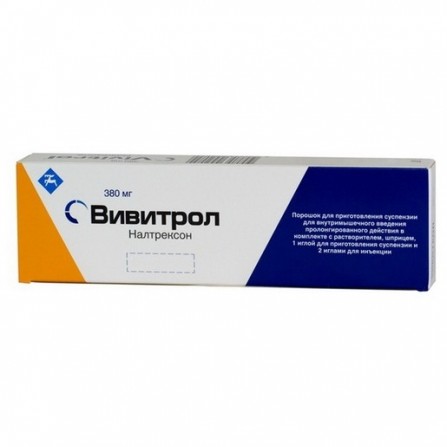Vivitrol powder for suspension preparation vnutremyshechno 380mg 4ml N1
Condition: New product
1000 Items
Rating:
Be the first to write a review!

More info
Active ingredients
Naltrexone
Release form
Powder
Composition
1 bottle contains: Active substance: naltrexone - 430 mg. Solvent: carmellose sodium (sodium carboxymethylcellulose), polysorbate 20, sodium chloride, water d / and (4 ml).
Pharmacological effect
Competitive opioid receptor antagonist. Eliminates the central and peripheral effects of opioids, including endogenous endorphins. Acts more intensively and for a long time than naloxone.
Pharmacokinetics
After oral naltrexone is almost completely absorbed from the gastrointestinal tract. Cmax of naltrexone and its active metabolite 6-β-naltrexol is reached in 1 hour. With prolonged use, naltrexone does not accumulate in the body, while the concentration of 6-β-naltrexol in plasma reaches 40%. This is because the T1 / 2 metabolite is larger than that of naltrexone. 95% of the naltrexone dose is biotransformed in the liver into pharmacologically active metabolites, the main of which, 6-β-naltrexol, is also an opioid antagonist. The second metabolite is 2-hydroxy-3-methoxy-6-β-naltrexol. Naltrexone and its metabolites undergo intrahepatic recirculation. Naltrexone and its metabolites are excreted mainly by the kidneys. The amount of free naltrexone that is excreted in the urine is less than 1%, and the amount of free and bound 6-β-naltrexol is approximately 38%. The average T1 / 2 naltrexone - 4 h, 6-β-naltrexol - 13 h.
Indications
As an aid in withdrawal after discontinuation of opioid analgesics.
Contraindications
Acute hepatitis, liver failure.
Use during pregnancy and lactation
The safety of naltrexone during pregnancy and lactation has not been established.
Dosage and administration
Is ingested. A single dose is 25-50 mg. The scheme and duration of treatment are set individually.
Side effects
From the side of the central nervous system: excitement, prostration, irritability, dizziness; rarely - depression, paranoia, fatigue, confusion, disorientation in time and space, hallucinations, nightmares, drowsiness, decreased visual acuity, pain and burning sensation in the eyes, photophobia, pain and a feeling of congestion in the ears, tinnitus.On the part of the digestive system: loss of appetite, diarrhea, constipation; rarely - dry mouth, flatulence, aggravation of hemorrhoid symptoms, erosive and ulcerative lesions of the gastrointestinal tract, increased activity of hepatic transaminases. On the part of the urinary system: rarely - increased or impaired urination. On the part of the reproductive system: delayed ejaculation, decrease in sexual potency; rarely, increased or decreased libido. Dermatological reactions: rash; rarely - increased secretion of sebaceous glands, athlete's foot, skin changes, corresponding to the 1st stage of frostbite. On the part of the respiratory system: rarely - hyperemia of the vessels of the nasal cavity, nasal bleeding, rhinorrhea, sneezing, dry throat, increased mucus, sinusitis, shortness of breath, tracheophony, cough, shortness of breath. Since the cardiovascular system: rarely - phlebitis, edema, increased blood pressure, nonspecific cardiogram changes, tachycardia, a feeling of heat in the limbs, a feeling of a sudden rush of blood to the face. Others: chills possible; seldom - increase or loss of appetite, increase in body weight, abnormal yawning, fever, pain in the inguinal region, increase in lymph nodes, lymphocytosis; described one case of idiopathic thrombocytopenic purpura in a patient who appeared to have been sensitized to naltrexone during a previous treatment.
Interaction with other drugs
With simultaneous use with naltrexone decreases the effectiveness of opioid receptor agonists (antitussives, analgesics).
special instructions
Naltrexone can only be used in cases where the patient does not take opioid analgesics for at least 7-10 days. Naltrexone can be effective in the treatment of chronic alcoholism. It is used with caution in patients with impaired liver and / or kidney function. During treatment, regular monitoring of liver function is recommended. Naltrexone should be discontinued at least 48 hours before surgery, which will require the use of opioid analgesics. It must be borne in mind that with the use of naltrexone, the probability of complete recovery from opioid dependence is variable.


